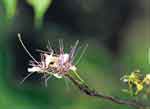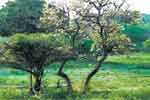|
|
||||
A little beauty with lots of medicinal value The Lunu warana, a small tree growing upto 25 feet is much branched with a greyish trunk. The leaves are compound made up of three leaflets each with a pointed tip, almost heart shaped. The tree is deciduous and sheds its leaves during December. The new leaves are pale green and bronze while the old leaves are yellow.
The whole tree has medicinal value. The bark and leaves are used to treat urinary diseases and stomach ailments and the bark to treat fevers, mild skin diseases and to relieve vomiting. In Sri Lanka a decoction of the powdered bark is used to cure stones in the kidney or bladder. The fresh leaves make a good substitute for a mustard poultice. In India the Lunu warana is used to prepare a snake- bite remedy. The wood of this tree is used to make toys and also sandals.
The Lunu warana is known as the Navala or Adicharanam in Tamil. The scientific name is Crataeva adansonii. It is also known as Crataeva religiosa since the tree is revered and worshipped in India. |
||||
Copyright © 2006 Wijeya Newspapers
Ltd. All rights reserved. |
 The
flowers of the Lunu warana are white or creamy yellow with purple
stamens. The flowers are clustered at the ends of the branches.
The flowering season is between February and April though some writers
describe a flowering season in December. The flowers appear with
the new leaves. The fruits are globose berries which appear on long,
woody stalks.
The
flowers of the Lunu warana are white or creamy yellow with purple
stamens. The flowers are clustered at the ends of the branches.
The flowering season is between February and April though some writers
describe a flowering season in December. The flowers appear with
the new leaves. The fruits are globose berries which appear on long,
woody stalks.  The
Lunu warana is indigenous to Sri Lanka, India, Burma and Africa.
Found in the dry and arid zones in scrub and monsoon forests, it
is common in Jaffna, Trincomalee, Dambulla and Hambantota. If you
are travelling in the dry zone, for instance Yala, look out for
these beautiful trees in bloom.
The
Lunu warana is indigenous to Sri Lanka, India, Burma and Africa.
Found in the dry and arid zones in scrub and monsoon forests, it
is common in Jaffna, Trincomalee, Dambulla and Hambantota. If you
are travelling in the dry zone, for instance Yala, look out for
these beautiful trees in bloom.